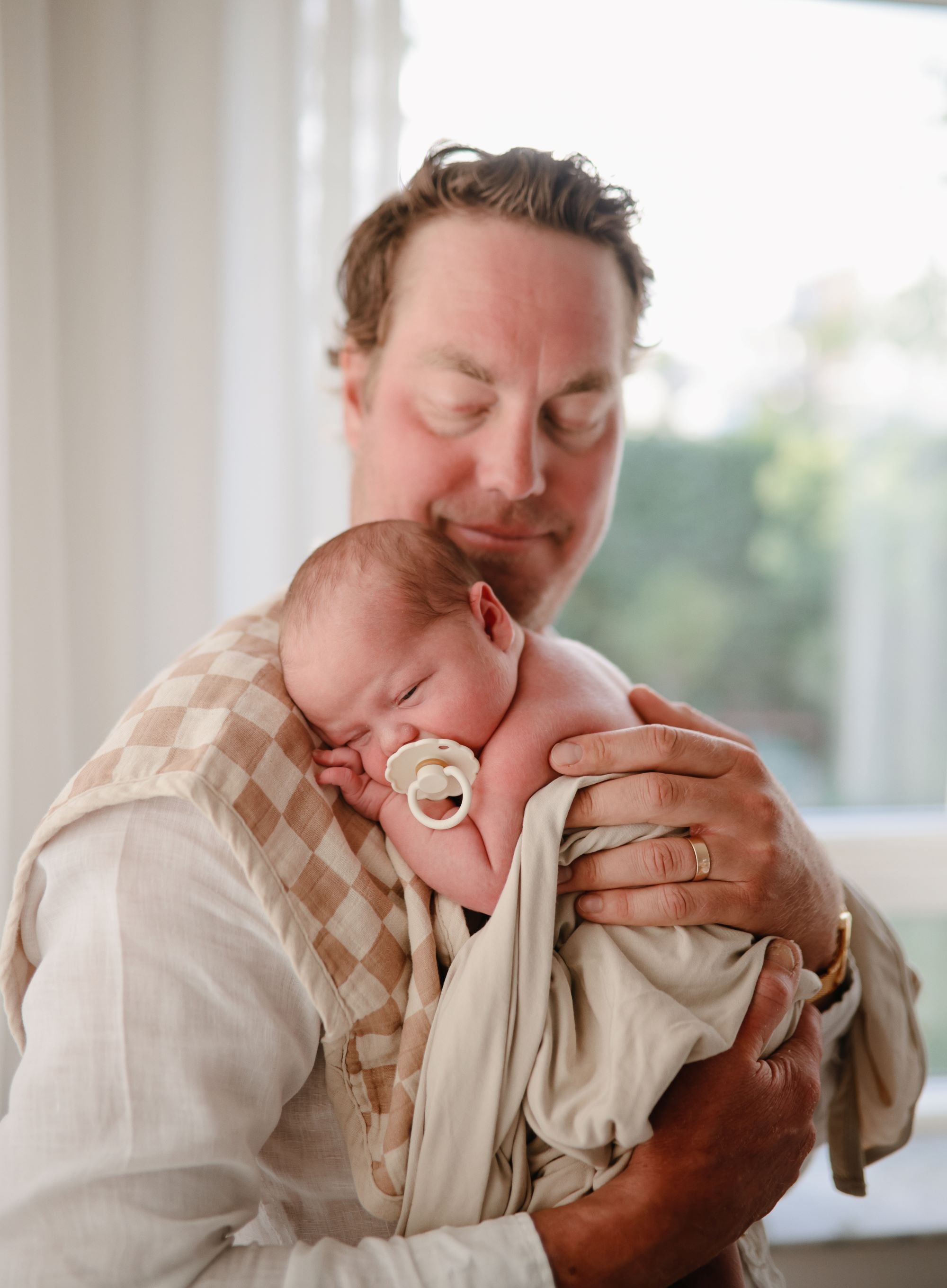What is a Short Nap for Newborns? Is a 30-Minute Nap Enough for a Newborn?
Any nap that is shorter than the average sleep cycle length (around 50 minutes) is considered a short nap. Why? When a nap is longer than 50 minutes, it means that your baby has successfully connected one sleep cycle to the next. So, yes, if your newborn only sleeps for 30 minutes, that is a short nap. BUT, short naps are completely normal and developmentally appropriate for babies during the first few months. Longer naps will come with time. Don’t let short naps take away from your happiness.
What Should Parents Do If Short Naps Are Normal for Newborns?
All of these "secrets" are available in my other blog about 6 Tips for Newborn Sleep Up to 5 Months . I will teach you how to organize your day successfully, work towards longer sleep times, help your baby learn to sleep independently, and much more. I want you to enjoy this newborn stage.
Why Does My Newborn Baby Take Short Naps?
Simple answer: Many newborns are not developmentally ready for consistent, longer naps.
While short naps are normal and developmentally appropriate for newborns, here are some reasons why short naps are more likely to occur:
- Your Baby Is Overtired . During the first three months, the typical wake window is between 60-90 minutes (sometimes closer to 35-60 minutes during the first few weeks). Tracking your baby’s sleepy cues will help you find the wake window that works best for them. If your baby is showing signs of being sleepy or has been awake for 90 minutes, you may want to offer a nap to avoid overtiring them.
- Your Baby Isn’t Tired Enough. We don’t want to overtired your baby, but we also want to make sure that they’re awake long enough to be ready for a nap. If you’re seeing signs of drowsiness and your baby has only been awake for less than 60 minutes (for babies 4 weeks or older), try doing a different activity to keep them awake a little longer. Check out our tips on newborn play for ideas on how to do this.
- Your Baby is Hungry. Newborns often fall asleep while feeding. I know it can be hard, but keeping your baby awake during feedings can make a big difference. This will help your baby get a full feed and allow for an age-appropriate wake window.
- Your Baby's Sleep Environment Isn't Supportive of Sleep. As babies get older, they become more aware of their surroundings, which can interfere with their sleep. Make sure their sleep environment is safe, dark, a comfortable temperature, and has a constant sound from a sound machine .
- Your Baby’s Unconscious Movements During Sleep Are Waking Them Up . Newborns can be very active while sleeping. Swaddling your baby until they show signs of rolling over can help prevent this active sleep from waking your baby up. How? Swaddling prevents the sudden movements that are so common in newborns and calms the Moro reflex.
Expert Tip: Sometimes, we cause short naps by interfering while our newborns are still asleep. Newborns can be noisy and active even when they’re sleeping, so make sure your baby is fully awake before you assume nap time is over.
When Do Babies Start Taking Longer Naps? When Do Baby Naps Start to Become Regular?
Typically, babies start to have more consistent and regular naps around 5 months of age. Did you catch that? Before 5 months, naps of 20-120 minutes are normal and developmentally appropriate for a newborn. I know short naps can make your day feel chaotic, especially when you’re trying to stick to a regular eating/playing/dreaming routine. But short naps are very common in the first few months of a baby’s life.
If your baby is 5 months or older and short naps are still a challenge, check out these reasons why your newborn might be having short naps .
Naps also tend to become more regular and consistent over time. You may notice that the first nap of the day is the easiest for your baby, while the last nap can be quite difficult. If possible, try to practice your baby’s first or second nap in a crib or bassinet . For more tips on how to practice longer naps with your baby, read our tips below .
How to Lengthen a Newborn's Short Nap Time?
Although short naps are common and developmentally appropriate, that doesn't mean you can't try to extend the nap time.
Here are some strategies you can try to extend your newborn's short naps:
- Change the pacifier (if your baby uses one)
- Swing or carry your baby
- Use a baby sling
Now, if you’ve tried putting your baby back to sleep for 10-15 minutes and it doesn’t work, that’s okay! Consider the nap over and start your baby’s next wake window. Keep practicing when you can, and remember, longer naps will come with time.
My Baby Wakes Up When I Try to Put Him Down for a Nap. What Can I Do?
Your baby falls asleep in your arms, and when you put him in his crib or playpen, his eyes open! You pick him up again, he falls asleep, you put him down, and he wakes up again! And the cycle repeats itself. I know how exhausting this is.
The change from being comfortably held to sleeping on a flat surface often wakes babies. If you try to put your baby down as soon as he falls asleep, try waiting a little longer (about 10 minutes) to allow him to enter a deeper stage of sleep before you put him down.
For more tips on helping your baby sleep in a crib or bassinet, check out the blog: How to Get a Newborn to Sleep in a Crib or Bassinet ?
What Does a Normal Day for a Newborn Look Like?
Because the length of a newborn's naps can vary greatly (20-120 minutes), there really is no "perfect daily schedule" for a newborn.
A hypothetical “normal” day might look something like this:
Hypothetical "Normal" Schedule for a Newborn:
6:30 AM: Baby wakes up and feeds
7:00 AM: Play time
7:30 AM: First nap (varies 20-120 minutes)
9:00 AM: Baby wakes up and feeds
9:30 AM: Play time
10:00 AM: Second nap (varies 20-120 minutes)
11:30 AM: Baby wakes up and feeds
12:00 PM: Play time
12:30 PM: Third nap (varies 20-120 minutes)
2:00 PM: Baby wakes up and feeds
2:30 PM: Play time
3:00 PM: Fourth nap (varies 20-120 minutes)
4:30 PM: Baby wakes up and feeds
5:00 PM: Play time
5:30 PM: Fifth nap (if needed, take a short 20-30 minute nap)
6:00 PM: Baby wakes up and feeds
6:30 PM: Quiet time and preparation for bed
7:00 PM: Night sleep
Did you notice that each nap in the schedule above lasts exactly two hours? This is not realistic for most newborns, right?
How Do I Adjust When the Day Isn't Going "Perfectly"? What Should I Do If My Newborn Has Short Naps?
If your newborn takes short naps (less than 50 minutes), you can:- Try extending your nap time
- End the nap effort and stay flexible
What Does Flexibility Look Like After a Short Nap?
- Pay attention to your baby and adjust your expectations for the day.
- Try to have the next nap when your baby shows signs of being sleepy or about 60-90 minutes after the previous nap ended.
- Continue offering feedings every 2-3 hours according to hunger cues.
- Try to do at least one activity between mealtimes and bedtime if possible.
Let's see how a day with a short nap might go.
Example of Short Nap Schedule for Newborn Baby Version 1
| Time | Activity |
| 6:30 AM | Wake Up & Feed |
| 7:00 AM | Play |
| 7:30–8:15 AM | Nap (45 minutes in the crib) |
| 8:15 AM | Build & Play |
| 9:00 AM | Breastfeeding |
| 9:15 AM | Changing diapers and swaddling (See how we added a little activity to separate mealtime and sleep time?) |
| 9:20–11:10 AM | Nap (110 minutes in the crib - A very long and unexpected sleep. Mom gets to enjoy a warm bath AND a nap too!) |
| 11:10 AM | Breastfeeding |
| 12:15–12:35 PM | SHORT NAP (20 minutes - Mom tried for 15 minutes to get him back to sleep. No luck.) |
| 12:35 PM | Play |
| 1:40 PM | Breastfeeding |
| 1:50–3:00 PM | Nap (70 minutes - Fell asleep on mom's lap while nursing because she was awake since 12:35pm. It's okay! NO GUILT! Mom got to enjoy her baby's cuddles!) |
| 3:00 PM | Play |
| 4:00 PM | Breastfeeding |
| 4:15 PM | Change diapers and swaddle (He fell asleep while Mom was swaddling him. That's okay!) |
| 4:20–5:20 PM | Nap (60 minutes - 25 minutes in crib, wakes up, Mom picks him up and he sleeps again for 35 minutes.) |
| 5:20 PM | Nursing (Cluster nursing: Note, it hasn't been 2 hours since the last feeding, but he's showing signs of hunger. Cluster nursing is common in the afternoon.) |
| 6:00 PM | Play |
| 6:15–6:45 PM | Nap (30 minutes - Fall asleep in bouncy chair) |
| 6:45–7:20 PM | Play |
| 7:20 PM | Breastfeeding |
| 7:35 PM | Bath, put on pajamas, sing, swaddle |
| 7:55 PM | Sleeping time |
| 10:00 PM | Breastfeeding while sleeping ( Dream Feed ) |
Do you see how the schedule is “perfect in its imperfection”? The baby is offered a feeding every 2-3 hours based on hunger cues, and the mother does her best to separate feeding and sleeping times. She offers naps. Sometimes the naps are long, sometimes they are short, so she tries to make them longer.
Here's another example.
Note that the same principles apply: offering feedings every 2-3 hours based on hunger cues, separating feeding and sleep times when possible, and offering naps after 60-90 minutes of wakefulness.
Example of Short Nap Schedule for Newborn Baby Version 2
| Time | Activity |
| 6:15 AM | Wake Up & Feed |
| 6:45 AM | Play |
| 7:30–8:15 AM | Nap (60 minutes - Baby falls asleep alone in crib. Wakes up after 15 minutes, Dad changes pacifier and rocks baby back to sleep.) |
| 8:15 AM | Build & Play |
| 9:15 AM | Breastfeeding |
| 9:35–11:00 AM | Nap (85 minutes - Baby falls asleep in Dad's arms. Notice baby has been awake for 80 minutes. He is swaddled and still sound asleep. No guilt. We will try to separate feeding and sleeping times later. Dad holds baby for 25 minutes, then puts him in the crib. Dad takes a shower.) |
| 11:00 AM | Build & Play |
| 11:30 AM | Breastfeeding (Dad fed early because he had lunch plans with friends. Baby didn't show any major signs of hunger, but still breastfed well.) |
| 12:00–12:15 PM | Nap (15 minutes - Ah! What a short nap. Baby falls asleep in the car seat and wakes up when lifted out of the car.) |
| 12:15–1:15 PM | Playing (being carried in a restaurant by a friend) |
| 1:15–2:30 PM | Nap Time (75 minutes - Baby falls asleep in the car seat while Dad shops.) |
| 2:30 PM | Breastfeeding |
| 3:00 PM | Play |
| 3:45–4:30 PM | Nap Time (45 minutes - Baby falls asleep on his own in the crib! Watch a newborn class to learn how.) |
| 4:30 PM | Breastfeeding (Baby shows clear signs of hunger and wants to nurse in groups.) |
| 5:00 PM | Nap (50 minutes - Baby naps for 10 minutes in the crib. Dad babywears to extend the nap.) |
| 5:50–6:40 PM | Play |
| 6:40 PM | Breastfeeding (Baby is a little fussy and wants to breastfeed in groups.) |
| 7:15 PM | Play |
| 7:40–8:15 PM | Nap Time (35 minutes - Dad holds baby in a swaddle, and baby falls asleep while parents clean up the kitchen after dinner.) |
| 8:15 PM | Build & Play |
| 8:45 PM | Bedtime Routine: Bath, diaper change, pajamas |
| 9:00 PM | Breastfeeding |
| 9:30 PM | Swaddled and put to bed for the night. (Parents decided not to do a dream feed .) |
The eat/play/dream routine is great, but short naps are very common in newborns. That’s okay. In fact, it’s more than okay; it’s perfect!
One day may seem like a perfect sleeper, but the next day may look completely different. This doesn’t mean there’s anything wrong; it just means your baby is a newborn. Growth spurts, brain development, and all the important work that a baby’s brain and body are doing on the inside can make them inconsistent on the outside.
Keep practicing the strategies from your newborn class. You are building a foundation, and practice is more important than a perfect schedule every day!
If your baby is past the newborn stage (13 weeks or older), don't worry. We have another article for you!






































































































